
| Crewing… So, you want to help out with a balloon? Balloon crew are an important part of our community. Without good, dependable crew a pilot won't be able to fly as she won't be able to set up a typical sized balloon for flight. For those who haven't crewed before we offer you the following crew information. Crewing is exciting and fun but it's also hard work but has great rewards. Crew are goodwill ambassadors of the ballooning community as they regularly deal with spectators and landowners. A crew person's #1 job is to assist the pilot. Most balloons have a crew of 3 to 6 people and most balloon crew are volunteer (don't get paid) as they love the sport. The most important things to remember: Pilot (or crew chief) is in charge No smoking - propane is a heavy gas which hangs at ground level and cigarettes do continue to burn once on the ground No drinking of alcohol until the balloon is packed away All pilots are different - listen to the one you are crewing for Don't step on the balloon envelope If you have a question, ask it! Have fun! What to Wear? Weather appropriate clothing (layers are a good thing for cold mornings) Long pants (remember there are ticks, briars, poison ivy, etc) Sturdy shoes (no sandals or flip-flops) Leather gloves (pilot usually provides) Things to watch out for: Wet grass in the morning Bugs Hot burners Dazed traffic Interested landowners Lots of "helpful" onlookers upon landing |
What is crewing all about?

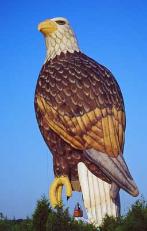
A general description about crewing for a hot air balloon
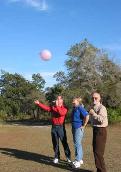
| You might wonder what those small balloons are that pilots release into the air. They're pibals (pilot balloons) and pilots use them to determine wind directions and speeds. This will help the pilot to make the decision of where to launch from and what direction they will be flying in. |
| Crew unload the balloon from the chase vehicle and help unpack it at the launch site. The basket should be laid down about 10 feet from the chase vehicle as it will be tied off to it. The pilot will attach the burners and propane lines to the basket after the uprights are attached. The envelope will be laid out in front of the basket in one of two ways, either it will be laid out or left in the bag and pulled out as it is filled with cold air. The cold air is supplied by a blower fan. |
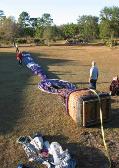
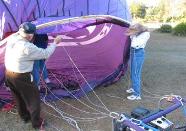
| Usually the pilot has 1 or 2 crew members hold the "throat" of the balloon while another mans the fan. |
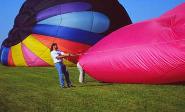
| Once the envelope is packed with cold air the pilot is then ready to put heat to it to bring it to an upright position. The fan will be turned off and the pilot will use the burner(s) to heat the balloon. The crew member(s) on the mouth will hold it open to allow the flame to enter into the balloon. The crown line crew member will come in as the balloon stands upright. Once in an upright position the crew assists the pilot by putting their weight on the basket until the passengers get in and the pilot is ready to take off. The crew also puts the fan and any other related items into the chase vehicle (make sure to leave the launch site in the same or better condition that it was in when you arrived). The pilot will take off and the passengers will start to enjoy their flight. |
| Another crew member will be holding the crown line attached to the top of the balloon to stabilize the balloon during inflation. |
| Once the balloon is in the air the chase begins. Don't discount the chase as it is usually a lot of fun. The crew in the chase vehicle will follow the balloon and usually talk to the pilot via radio. The idea is that the chase crew will be at the landing site as the pilot is landing to assist. The chase crew also acts as goodwill ambassadors by dealing with the public, both onlookers and land owners. Remember that most people have not been around balloons so when they land some people think they've actually crashed and may call for public assistance. As crew you can help to answer questions that onlookers may have. Crew also try to locate the landowner of the landing site to obtain permission. Remember we are using someone else's land and we should have permission to land there and retrieve the balloon. Some landowners do not want balloons landing on their property so we call this a "red zone". Remember that every landing without permission is officially considered trespass so you need to make sure not to damage someone's property and again leave it in the same or better condition that it was in when you arrived. As balloonists we thank the landowner and many even still give them a bottle of champagne. |
| Most pilots have their own crew to assist them during their flights but when they travel to rallies their local crew might not be available. Pilots also like to have a "local" crew person as they usually know the roads in the area. This is where additional crew comes in handy. If you're interested in crewing for a balloon pilot then you can speak with them personally (at their landing or call one in the phone book) or during a rally you should contact the rally management for crew opportunities. While pilots normally don't pay their crew cash they do thank them in other ways and on occasion have been known to give their crew rides in the balloon. |
| Crew positions - the pilot or crew chief will direct the crew on what to do. Fan - the fan is one of the most dangerous items on the launch field and should be shown great respect and handled with care. The pilot will place and start the fan Know where the kill switch and speed controls are Tie back long hair and secure loose clothing or dangling items Never move the fan when it is running Stand behind the fan Never tip the fan back while running When signalled by the pilot hit the kill switch, wait for the fan to stop and then move the fan out of the way DON'T forget to load the fan in the chase vehicle before leaving the launch site Crown line The crown line person stabilizes the envelope during inflation and acts as an anchor for the rising balloon. Usually the pilot will choose a large, strong person for this position. Don't put the rope around any part of you Make sure you have gloves on Pull with your weight - knees bent - pull hard and steady Act as an anchor, don't try to counter the roll of the balloon Keep pressure on the balloon as it rises until the pilot tells you to come in Give the crown line to the pilot for connecting to the uprights Throat These crew members hold the mouth of the balloon open so the fan can fill the envelope with cold air. Watch the pilot for any signals she may give. Once the balloon is cold packed the pilot will then turn on the burner and put heat to the balloon. Keep the throat of the balloon open until the balloon starts to come upright. At this point put your weight on the basket as it stands upright. Keep your feet outside of the ropes and off the small white electrical wire When putting weight on the basket watch your feet to make sure they aren't under the basket as it tips upright lessen their weight on the balloon. The pilot will release the tie-off rope (watch out in case the rope springs back lessen their weight on the balloon. The pilot will release the tie-off rope (watch out in case the rope springs back towards the chase vehicle). The pilot may ask the crew to walk the balloon away from the chase vehicle or another balloon as she ascends. balloon as she ascends. Never hold onto any part of the balloon or basket as the pilot is taking off - do not leave the ground unless you are in the basket - let go at all costs as a drop from any height can cause injuries. Chase Once the pilot has left the launch site the crew chief is in charge and will direct the chase crew in loading the fan, tie-off ropes and any other items left at the launch site. Once a re-check of the area to make sure that nothing is being left the chase crew will load into the vehicle to chase the balloon. Follow all driving regulations The driver of the chase vehicle should keep their attention on driving not the balloon or a map Other crew should watch the balloon and direct the driver appropriately Don't drive onto someone's property without permission Try to stay ahead of the balloon to assist the pilot on landing Realize that other drivers will be watching the balloon too and may not be paying attention to their driving The pilot can land without a chase crew being there so don't be worried - be SAFE Don't get in front of the basket as it is landing Landing When the pilot advises that she is going to land the crew should be ready to assist with gloves on. One crew member should try to locate the landowner to obtain permission to use the area to land in and retrieve the balloon. The pilot can land without ground crew assistance but usually prefers to have the crew there to help. When the balloon is coming in to land do not get in front of it as it will knock you down and can injure you if it lands on you. Try to "catch" the balloon by the sides or back of the basket as it hits the ground and put your weight on the basket. Once the balloon stops moving keep your weight on until the pilot tells you what to do next. The pilot will pull out the top to release the air and the envelope will come down. One crew member should have the crown line and pull the envelope out straight as it descends to the ground. The pilot and crew will then "milk" the rest of the air out of the balloon and put the envelope in its bag. The crew then loads the basket, envelope and burners back into the chase vehicle. Make sure to check the landing site for any items that might have been dropped. Once this is done it's time for the celebration. Champagne and soft drinks are served and shared with the pilot, passengers, crew and landowners to thank them for their help. |

All Photos are the exclusive property of Hot Air Balloon Crew unless stated otherwise.
No pictures may be used without our express written permission. Copyright 2007
No pictures may be used without our express written permission. Copyright 2007
